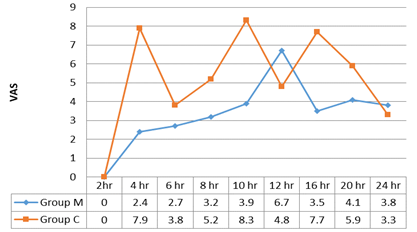Efficacy and Safety of Intrathecal Morphine For Post Cesarean Analgesia Under Spinal Anesthesia
Abstract
Background: Cesarean section is the most common operation in obstetrics. It is also a well-known fact that mother has to bear severe post-operative pain because of unavailability of better analgesic and modern techniques of pain control at all the centre and that too free of cost, in the current era of cost containment. Objective: To evaluate the efficacy and safety of intrathecal morphine for post cesarean analgesia under spinal anesthesia. Methods: This prospective, randomized, case-control study was conducted in Department of Anaesthesiology, Gonoshasthaya Samaj Vittik Medical College, Savar, Dhaka, Bangladesh from January to June 2022. A total of 150 parturients posted for Cesarean section under spinal anesthesia were divided into two groups of 75 each in this prospective randomized case-control study. Morphine group received 0.15 mg of intrathecal morphine mixed in 12 mg of 0.5% bupivacaine heavy while control group received 12 mg of 0.5% bupivacaine heavy alone, after proper preparation of spinal anesthesia. The parturients were assessed for first request of analgesic as per Visual Analog Scale, frequency of analgesics required within 24hr, nausea, vomiting, pruritus, sedation and respiratory depression. Results: Postoperative analgesia was significantly greater in morphine group as compare to control group (12.1±7.6 vs 3.7±2.9hr). Frequency of analgesics requirements was also significantly lower in morphine group (1.7±2.0 vs 3.4±8.1). Visual Analog Scale was below 4 at most of time in morphine group. The incidence of nausea, vomiting and pruritus were more in morphine group as compare to control group but without any respiratory depression. There was no significant difference in APGAR score among fetus. Conclusion: Mixing low dose of intrathecal morphine in standard dose of spinal anesthesia effectively prolongs the duration of post cesarean analgesia and decreases the frequency of analgesics requirement without any major complication in parturients or fetus.
Downloads
References
Ferguson SE, Malhotra T, Seshan VE, et al: A prospective randomized trial comparing patient-controlled epidural analgesia to patient-controlled intravenous analgesia on postoperative pain control and recovery after major open gynecologic cancer surgery. Gynecol Oncol 2009; 114: 111 – 116.
Chen LM, Weinberg VK, Chen C, et al: Perioperative outcomes comparing patient controlled epidural versus intravenous analgesia in gynecologic oncology surgery. Gynecol Oncol 2009; 115: 357 – 361.
Briggs GG, Berman ML, Lange S, et al: Morphine: continuous intravenous infusion versus intramuscular injections for postoperative pain relief. Gynecol Oncol 1985; 22: 288 – 293.
Baraka A, Noueihid R, Hajj S. Intrathecal injection of morphine for obstetric analgesia. Anesthesiology 1981; 54:136-40.
Gustafsson LL, Schildt B, Jacobsen K. Adverse effects of extradural and intrathecal opiates: report of a nationwide survey in Sweden. Br J Anaesthiol 1982; 54:479-86.
Gjessing J, Tomlin PJ. Postoperative pain control with intrathecal morphine. Anesthesia 1981; 36:268-76.
Chaney M. Side effects of intrathecal and epidural opioids. Can J Anesth 1995; 42:891-903.
Behar M, Magora F, Olshwang D, Davidson JT. Epidural morphine in the treatment of pain. Lancet 1979; 1:527-9.
Wang JK, Nauss LA, Thomas JE. Pain relief by intrathecally applied morphine in man. Anaesthesiology 1979; 50:149-151.
Kalso E. Effects of intrathecal morphine injected with bupivacaine on pain after orthopaedic surgery. Br J Anesthiol 1983; 55:415-22.
Nordberg G, Hedner T, Mellstrand T, Dalistrom B. Pharmacokinetic aspects of intrathecal morphine analgesia. Anesthesiology 1984; 60:448-54.
Chadwick HS, Ready LB. Intrathecal and epidural morphine sulphate for postcesarean analgesia: a clinical comparison. Anesthesiology 1988; 67:137-43.
Odoom JA, Sih IL. Respiratory depression after intrathecal morphine. Anesth Analg 1982; 61:70.
Davies GK, Tolhurst-Cleaver CL, James TL. Respiratory depression after intrathecal narcotics. Anesthesia 1980; 35:1080-3.
Glynn CJ, Mather LE, Cousin LE, Wilson PR, Graham JR. Spinal narcotics and respiratory depression. Lancet 1979; 2:356-7.
Abboud TK, Dror A, Mosaad P, Zhu J, Mantilla M, Swart F. Mini-dose intrathecal morphine for the relief of post-cesarean section pain. Anesth Analg 1988;67:137-43.
Abouleish E, Rawal N, Fallon K. Combined intrathecal morphine and bupivacaine for cesarean section. Anesth Analg 1988; 67:370-4.
Kirson LE, Goldman JM, Slover RB. Low-dose intrathecal morphine for postoperative pain control in patients undergoing transurethral resection of prostate. Anesthesiology 1989; 71:192-5.
Allano C. Low dose spinal morphine for postop analgesia on surgical wards. Br J Anesthesiol 1999; 82:189.
Blitt CD, Kaufer-Bratt C, Ashby J, Caillett JR. QA program reveals safety issues, promotes development of guidelines: AZ practice model. APSF Newsletter 1994; 9:17-9.
Abouleish EI. No need to avoid spinal narcotics [letter] APSF Newsletter 1994; 9:50.
Abouleish E. Apnoea associated with intrathecal administration of morphine in obstetrics. Br J Anaesth 1988; 60:592-4.
Scott PV, Fisher HB. Intraspinal opiates and itching: A new reflex? BMJ 1982:284:1015-6.
Gwirtz KH, Young JV, Byers RS. The safety and efficacy of intrathecal opioid analgesia for acute postoperative pain: seven years’ experience with 5969 surgical patients at Indiana University hospital. Anesth Analg 1999; 88:599-604.



























